National Commission on September 11 Terrorist Attacks
It makes for chilling reading. The following is a transcript
of testimony before the Commission by Maj. Gen. Craig McKinley,
Maj. Gen. Larry Arnold and Col. Alan Scott May 23, 2003, all
current or retired Air Force Officers who were based at NORAD on
Sept. 11, 2001.
NORAD Timeline
Col. Alan Scott
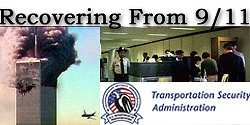 Good
morning Mr. Chairman, Commissioners. It is my pleasure to be
here with you today. General Arnold and I worked together
that day on September 11th. What I will walk you through here
is a chronology of the attacks and I presented it in a matrix
form. And the only thing I lay claim to is having studied all
of the attacks and how they were interwoven together. This
was not a linear sequence of events where one attack began and
ended and then a second attack began and ended. This was a
coordinated, well-planned attack. We had multiple airplanes
in the air. The fog and friction of war was evident
everywhere in the country both on the civil side as well as the
military side. And this hopefully will show you how those
interwoven events came about. I will tell you that the times
on this chart come from our logs. The time on the chart is
the time that's in the log. It may not be the exact time the
event happened. It may be the time when the log keeper was
advised or became aware of the event.
Good
morning Mr. Chairman, Commissioners. It is my pleasure to be
here with you today. General Arnold and I worked together
that day on September 11th. What I will walk you through here
is a chronology of the attacks and I presented it in a matrix
form. And the only thing I lay claim to is having studied all
of the attacks and how they were interwoven together. This
was not a linear sequence of events where one attack began and
ended and then a second attack began and ended. This was a
coordinated, well-planned attack. We had multiple airplanes
in the air. The fog and friction of war was evident
everywhere in the country both on the civil side as well as the
military side. And this hopefully will show you how those
interwoven events came about. I will tell you that the times
on this chart come from our logs. The time on the chart is
the time that's in the log. It may not be the exact time the
event happened. It may be the time when the log keeper was
advised or became aware of the event.
The first thing that happened in the morning, related to,
related to the events at 9:02, or I'm sorry, 8:02 A.M., EST, is
when American Airlines 11 took off out of Boston. American
Airlines 11 was a 767 and it was headed, I believe, to Los
Angeles
Fourteen minutes later, also coming out of Boston Logan, United
Airlines 175, a 757, also headed to Los Angeles, took off out of
Boston and initially took roughly the same ground track as American
11. Three minutes later American Airlines 77 took off out of
Dulles here in Washington, also headed to Los Angeles and also a
757 and proceeded westbound towards the West Coast. So now
the first three airplanes are airborne together.

The first time that anything untoward and this was gleaned from
FAA response and anything out of the ordinary happened was at 8:20
when the electronic transponder in American Airlines 11 blinked
off, if you will, just disappeared from the screen. Obviously, the
terrorists turned that transponder off and that airplane, although
it did not disappear from the radar scope, it became a much, much
more difficult target to discern for the controllers who now only
could look at the primary radar return off the airplane. That was
at 8:20. At 8:40, in our logs is the first occasion where the
FAA is reporting a possible hijacking of American Airlines Flight
11. And the initial response to us at that time was a
possible hijacking; it had not been confirmed.
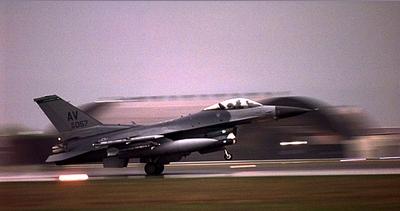
At that same moment, the F-15 alert aircraft at Otis Air Force
Base, Massachusetts, about 153 miles away were placed immediately
on battle stations by the Northeast Air Defense Sector
Commander.
At 8:43, as this is going on, the fourth airplane, United 93
takes off out of Newark, New Jersey. It's a 757; it is headed
for San Francisco.
At 8:46, our next log event, we get the last and by the way,
much of this radar data for these primary targets was not seen that
day. It was reconstructed days later by the 84th Radar
Evaluation Squadron and other agencies like it who are
professionals at going back and looking at radar tapes and then
given that they are loaded with knowledge after the fact, they can
go and find things that perhaps were not visible during the event
itself.
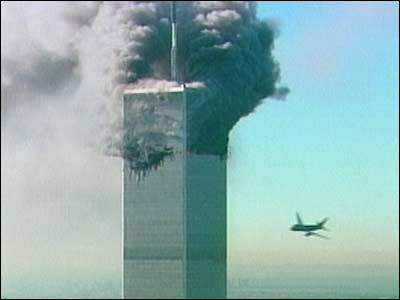
At 8:46, the last data, near the Trade Center. 8:46, the
first impact on the Trade Center. At that minute is when the Otis
F-15s were scrambled and, again, they are 153 miles away. And
that scramble came and Gen. Arnold, I'm sure can address this,
based on the conversation between the Northeast Sector Commander
and himself.
Those F-15s were airborne in six minutes. That is well
inside the time that is allowed for them to get airborne. But
because they were on battle stations, the pilots were in the
cockpits ready to start engines, that scramble time was shortened
by a significant amount of time.
At 8:53, that's a minute later, in the radar reconstruction, we
are now picking up primary radar contacts off of the F-15s out of
Otis.
At 8:57, which is seven minutes after the first impact is
according to our logs when the FAA reports the first impact.
And about this time is when CNN coverage to the general public is
beginning to appear on the TV, not of the impact, but of the
burning tower shortly thereafter. So, you can see what in the
military, I'm sure you have heard us talk to the fog and friction
of war. And as the intensity increases, the lag tends to also
increase for how quickly information gets passed.
At 9:02, United 175, the second airplane, which by the way,
never turned off its transponder before impact, crashes into the
North Tower, at 9:02. The distance of those fighters which
had been scrambled out of Otis, at that particular point they were
still 71 miles away, about 8 minutes out and going very fast.
At 9:05, FAA reports a possible hijack of United 175.
Again that's 3 minutes after the impact in the Tower. It's
how long it is taking now for the information to flow through the
system to the command and control agencies and through the command
and control agencies to the pilots in the cockpits.
At 9:09, Langley F-16s are directed to battle stations just
based on the general situation, and the breaking news and the
general developing feeling about what's going on. And about
that same time, kind of way out in the west is when American 77,
which in the meantime has turned off its transponder and turned
left back toward Washington, appears back in radar coverage.
And my understanding is the FAA controllers now are beginning to
pick up primary skin paints on that airplane and they don't know
exactly whether that is 77 and they are asking a lot of people
whether it is, including a C130 that's westbound toward Ohio.
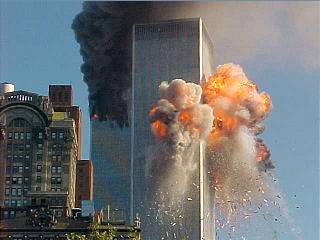
At 9:11, the FAA reports a crash into the South Tower. You
can see now that lag time has increased from 7 minutes from impact
to report, and now it's 9 minutes from impact to report and you can
only imagine what's going on on the floors of the control centers
around the country.
At 9:11, I just mentioned that, 9:16, now FAA reports a possible
hijack of United Flight 93, which is out in the Ohio area.
That's the last flight that is going to impact the ground.
At 9:24, the FAA reports a possible hijack of 77. That's
some time after they had been tracking its primary target.
And at that moment as well is when the Langley F-16s were scrambled
out of Langley.
At 9:25, American 77 is reported heading toward Washington,
D.C., not exactly precise information, just general information,
across the chat log.
9:27, Boston FAA reports a fifth aircraft missing, Delta Flight
89. And you people have never heard of Delta Flight 89. We
call that the first red herring of the day because there are a
number of reported possible hijackings that unfolded over the hours
immediately following the actual attack. Delta 89 was not
hijacked. It enters the system. It increases the fog
and friction, if you will, as we begin to look for that. But
he lands about 7 or 8 minutes later and clears out of the
system.
At 9:30, that Langley F-16s are airborne. They are 105
miles away from the Washington area.
At 9:34, through chat, FAA is unable to precisely locate
American Airlines Flight 77.
At 9:35, F-16s are reported airborne. And many times,
reported airborne is not exactly when they took off, it's just when
the report came down that they were airborne.
At 9:37, we have the last radar data near the Pentagon and 9:40,
immediately following that, is when 93 up North turns it
transponder off, out in the West toward Ohio and begins a left turn
back toward the East.
At 9:49, FAA reports that Delta 89, which had been reported as
missing, is now reported as a possible hijacking so again, he
is.... I'm sorry 9:41. Again he is in the system. He is
kind of a red herring for us.
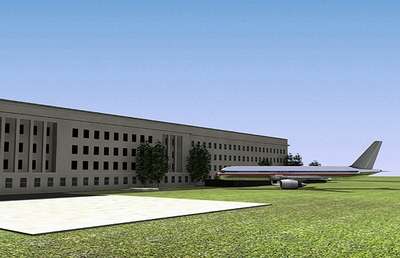
Now the only thing that I would point out on this chart is that
this says 9:43, American Airlines 77 impacts the Pentagon (shown in
simulation, above). The timeline on the impact on the
Pentagon was changed to 9:37. 9:43 is the time it was
reported that day. It was the time we used. And it took
about two weeks to discover in the parking lot of the Pentagon this
entry camera for the parking lot, which happened to be oriented
toward the Pentagon at the time of impact. And the recorded
time is 9:37. And that's why the timeline went from 9:43 to
9:37 because it is the best documented evidence for the impact time
that we have.
Getting toward the end now, 9:47 is when Delta 89 clears the
system by landing in Cleveland. So he is not a hijack.
Lots of things are going on now in the system as the Sectors begin
to call both units that are part of First Airforce and NORAD as
well as units that have nothing to do with us. We are
beginning to call everyone now and the 103rd Air Control Squadron,
for instance, stationed in Connecticut is an Air Control Squadron,
a radar squadron, and they got their radar online operational and
begin to link their radar picture into the Northeast system.
They are not normally part of NORAD. This is really the
initial part of a huge push the rest of that day to link as many
radars in on the interior as we can, and to get as many fighters on
alert as we can.
At 10:02, United 93, last radar data and the estimated impact
time for United 93 is 10:03.
At 10:07, FAA reports that there may be a bomb on board
93. That's four minutes after the impact.
At 10:15, they report that it's crashed and you can see now the
fog and friction lag time has increased from 7 minutes to 9 minutes
to 15 minutes because of the level of activities that are going
on.
And there are notations here about other airplanes as we begin
to divert other airplanes that are just out intended for training
that day. We're picking up the phone, calling Syracuse the
Air National Guard. They are beginning to get flights
airborne. They are beginning to arm those aircraft with
whatever weapons they have handy so we can posture that
defense.
That is how the timeline unfolded. As you can see, there
is a fabric of interwoven actions, which is not just a linear
event. So lots of things going on, lots of activities, lots
of CQ centers. Sir, that concludes my piece.
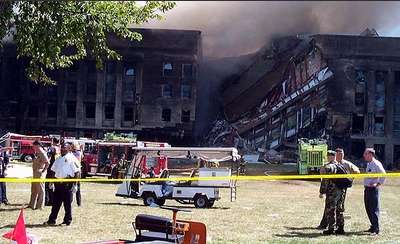
Maj. Gen. Craig McKinley
Mr. Chairman, we thought, right up front, we'd put that on the
record so that we could have that as a departure point for your
questions. I again caveat by saying that this is the North American
Aerospace Defense Command and Continental NORAD Region
timeline. Other agencies may have other logs that may have
different times. But this is the best and most accurate data
that we could piece together for your Commissioner, sir. With
that, I open up to questions.
Thomas Kean, Committee Chairman
Thank you very much. Commissioner Ben-Veniste?
Richard Ben-Veniste, Commissioner
Good morning Gentlemen. First I would like to personally
commend each of you and the dedicated men and woman who serve our
nation through NORAD. I'd like to explain to you what you
probably know already and that is that our mandate as the
Commission is to provide the most detailed and accurate exposition
in our final report of what occurred leading up to the 9/11 tragedy
and the events subsequent thereto. And so, please understand
that our questions may be very pointed. We mean no disrespect
but we have our mission, as well. Now, Gen. McKinley, is it fair to
say that the mission and the primary responsibility of NORAD is to
defend our homeland and our citizens against air attack?
Maj. Gen. Craig McKinley
On the day of September 11, 2001, our mission was to defend
North America, to surveil, to intercept, to identify and if
necessary to destroy those targets, which we were posturing were
going to come from outside our country. In fact, that tracks
originating over the landmass of the United States were identified
friendly by origin. Therefore, those alert sites that were
positioned on the morning of September 11th, were looking out,
primarily on our coasts at the Air Defense Identification Zone
which extends outwards of 100 to 200 miles off our shore. So
that was the main focus of NORAD at the time.
Richard Ben-Veniste, Commissioner
I asked you about your responsibility, Sir. And I ask you
again whether it was not your responsibility as NORAD to protect
the United States and its citizens against air attack?
Maj. Gen. Craig McKinley
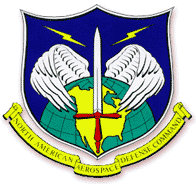 It is and it was and I would just caveat your
comment by saying that our mission was, at that time, not designed
to take internal FAA radar data, to track or to identify tracks
originating within our borders. It was to look outward as a
Cold War vestige, primarily developed during the Cold War to
protect against Soviet long-range bomber penetration of our
intercept zone.
It is and it was and I would just caveat your
comment by saying that our mission was, at that time, not designed
to take internal FAA radar data, to track or to identify tracks
originating within our borders. It was to look outward as a
Cold War vestige, primarily developed during the Cold War to
protect against Soviet long-range bomber penetration of our
intercept zone.
Richard Ben-Veniste, Commissioner
Well I think Sir, you have used a good term - not good for the
United States but accurate, in terms of the vestigial mandate
operationally to look outward toward the borders rather than
inward. And by vestigial, you mean I'm sure, as a result of
our decades of confrontation with the former Soviet Union.
Maj. Gen. Craig McKinley
Correct, Sir.
Richard Ben-Veniste, Commissioner
And so, on the day of September 11th, if you can see these dots,
I know it may be difficult to see, NORAD was positioned in a
perimeter around the United States but nothing in the central
region, nothing on the border with Canada.
Maj. Gen. Craig McKinley
That's correct, Sir.
Richard Ben-Veniste, Commissioner
Now let me ask you sir, whether the concept of terrorists using
an airplane as a weapon was something unknown to the intelligence
community on September 10th, 2001?
Maj. Gen. Craig McKinley
Very good question...
Richard Ben-Veniste, Commissioner
Thank you.
Maj. Gen. Craig McKinley
And I asked our staff to provide me some data on what they had
that morning. As I said, Gen. Arnold was at the helm that
morning. But basically, the comments I received from my staff
was that there was no intelligence indication at any level within
NORAD or DOD of a terrorist threat to commercial aviation prior to
the attacks. And information from the daily Joint Chiefs
Intelligence Report on the morning of September 11th indicated no
specific dangers or threats within the country.
Richard Ben-Veniste, Commissioner
 My question Sir, and I mean no disrespect but we
will save time if you'll listen to what ask you. My question
is: the concept of terrorists using airplanes as weapons was not
something which was unknown to the U.S. Intelligence community on
September 10th, 2001. Isn't that fair to say?
My question Sir, and I mean no disrespect but we
will save time if you'll listen to what ask you. My question
is: the concept of terrorists using airplanes as weapons was not
something which was unknown to the U.S. Intelligence community on
September 10th, 2001. Isn't that fair to say?
Maj. Gen. Craig McKinley
I would like the Intelligence community to address that. I
would find it hard to believe that they hadn't speculated against
that. But it was unavailable to us at the time.
Richard Ben-Veniste, Commissioner
Well, let's start for example with September 12th, 1994. A
Cessna 150L crashed into the south lawn of the White House barely
missing the building and killing the pilot. Similarly, in
December of 1994, an Algerian armed Islamic group in Paris hijacked
an Air France flight in Algiers and threatened to crash it into the
Eiffel Tower. In October of 1996, the Intelligence community
obtained information regarding an Iranian plot to hijack a Japanese
plane over Israel and crash it into Tel Aviv. In August of
1998, the Intelligence community obtained information that a group
of unidentified Arabs planned to fly an explosive-laden plane from
a foreign country into the World Trade Center. The
information was passed on to the FBI and the FAA.
In September of 1998, the Intelligence community obtained
information that Osama bin Laden's next operation could possibly
involve flying an aircraft loaded with explosives into a U.S.
airport and detonating it. In August 2001, the Intelligence
Community obtained information regarding a plot to either bomb the
U.S. Embassy in Nairobi from an airplane or crash an airplane into
it.
In addition, in the Atlanta Olympics, the United States
government and the Dept. of Justice and my colleague Jamie Gorelick
were involved in planning against possible terrorist attacks at the
Olympics, which included the potential of an aircraft flying into
the stadium. In July 2001, the G8 Summit in Genoa, attended
by our President - among the measures that were taken, were
positioning surface-to-air missiles, ringing Genoa, closing the
Genoa airport and restricting all airspace over Genoa. Was
not this information, Sir, available to NORAD as of September 11th,
2001?
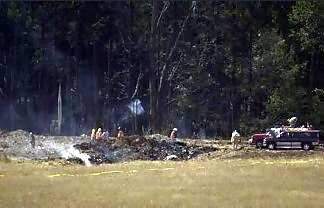
Maj. Gen. Craig McKinley
It's obvious, by your categorization that those events all took
place and that NORAD had that information. I would only add,
Sir, that the intelligence data that we postured our forces for and
the training, and the tactics, and the procedures that we used to
prepare our missions for support of the Combatant Commander of
NORAD, had hijacking as a primary intercept tactic. And we
have some of the finest fighter pilots as you know in the world who
are some of the best people in the world, who can do their mission
extremely well. But we had not postured, prior to September 11th,
2001, for the scenario that took place that day.
Richard Ben-Veniste, Commissioner
Well, obviously, it would be hard to imagine posturing for the
exact scenario but isn't it a fact, Sir, that prior to September
11th, 2001, NORAD had already in the works, plans to simulate in an
exercise, a simultaneous hijacking of two planes in the United
States.
Maj. Gen. Craig McKinley
Col. Scott, do you have any data on that? I'm not aware of
that, Sir. I was not present at the time.
Richard Ben-Veniste, Commissioner
That was operation Amalgam Virgo.
Col. Alan Scott
Yes, Sir. Specifically, operation Amalgam Virgo, which I
was involved in before I retired, was a scenario using a
Third-World United, not United, uninhabited aerial vehicle launched
off a rogue freighter in the Gulf of Mexico. General Arnold
can back me up, at the time, one of our greatest concerns was the
proliferation of cruise missile technology and the ability for
terrorists groups to get that technology and get it close enough to
our shores to launch it. In fact, this exercise, in this
exercise we used actual drone, MQM 107 drones, which are about the
size of a cruise missile to exercise our fighters and our radars in
a Gulf of Mexico scenario.
Richard Ben-Veniste, Commissioner
You are referring to Amalgam '01, are you not?
Col. Alan Scott
Yes, Sir.
Richard Ben-Veniste, Commissioner
I'm referring to Amalgam '02, which was in the planning stages
prior to September 11th, 2001, Sir. Is that correct?
Col. Alan Scott
That was after I retired and I was not involved in '02.
Richard Ben-Veniste, Commissioner
Will you accept that the exercise involved a simultaneous
hijacking scenario?
Col. Alan Scott
I was not involved in '02.
Maj. Gen. Craig McKinley
Sir, I do have some information on '02, if you would allow me to
read it for the record?
Richard Ben-Veniste, Commissioner
Please.
Maj. Gen. Craig McKinley
Amalgam Virgo, in general, '02, was an exercise created to focus
on peacetime and contingency NORAD missions. One of the
peacetime scenarios that is and has been a NORAD mission for years
is support to other government departments. Within this
mission falls hijackings. Creativity of the designer aside,
prior to 9/11, hijack motivations were based on political
objectives, ie: asylum or release of captured prisoners or
political figures. Threats of killing hostages or crashing
were left to the scriptwriters to invoke creativity and broaden the
required response for players.
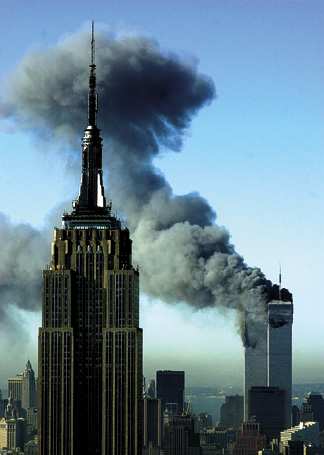
Richard Ben-Veniste, Commissioner
Well, isn't that a bit fatuous given the specific information
that I've given you? It wasn't in the minds of scriptwriters
when the Algerians had actually hijacked a plane which they were
attempting to fly into the Eiffel Tower and all the other scenarios
which I've mentioned to you. I don't mean to argue with you
but my question is, Sir, given the awareness of the terrorists' use
of planes as weapons, how was it that NORAD was still focusing
outward in protecting the United States against attacks from the
Soviet Union or elsewhere and was not better prepared to defend
against the hijackings scenarios of a commercial jet, laden with
fuel, used as a weapon to target citizens of the United
States? When you say, our training, our mission was
vestigial, I think you said it in capsulated form but would you
agree that on the basis of the information available, that there
could have been better preparedness by NORAD to meet this
threat?
Maj. Gen. Craig McKinley
In retrospect, Sir, I think I would agree with your comment.
Richard Ben-Veniste, Commissioner
With respect to the bases that were available for protecting the
East Coast, and Col. Scott has gone through the scrambling of
aircraft, I want to focus just on one flight, Flight 77, and then,
Secretary Lehman will ask you some more specific questions.
With respect to Flight 77, Sir, you testified previously before the
House Armed Services Committee and you were - I'm sorry, General
Eberhart was questioned. You are familiar with his testimony,
Sir?
Maj. Gen. Craig McKinley
Yes Sir.
Richard Ben-Veniste, Commissioner
Okay. He was questioned about Flight 77 and because of the
use of Langley Airbase, which is 105 miles from our Capitol, as
opposed to say Andrews Air Force Base, which is in the
neighborhood, the question arises again about the positioning and
the thought behind the positioning of fighter planes to protect our
Capitol in an enhanced terrorist threat situation, such as existed
on September 10th, September 9th, 2002. Let me ask you about
Flight 77 again. The question was, the timeline that we've been
given is that at 8:55 on September 11th, American Airlines Flight
77 began turning east, away from it's intended course and at 9:10,
Flight 77 was detected by the FAA radar over West Virginia, heading
east. That was after the two planes had already struck the
Trade Center towers. Is that correct Col. Scott?
Col. Alan Scott
Yes Sir
Richard Ben-Veniste, Commissioner
Now, 15 minutes later at 9:25, the FAA notified NORAD, according
to the statement, that Flight 77 was headed toward
Washington. (reading from the record)
"Was that the first notification at 9:25 that NORAD or DOD had
that Flight 77 was probably hijacked? And if it was, do you
know why it took 15 minutes for the FAA to notify NORAD?"
General Eberhart said, "Sir, there is one minor difference, I
showed it as 9:24 which you do as well that we were notified and
that's the first notification that we received."
"Do you know if that was the first notification to DOD?"
"Yes, Sir, that's the first documented notification that we
received"
And I want to focus on the word "documented" because it's very
important for us to know when NORAD actually received notification
given the fact that the planes had already crashed into the World
Trade Center and given, I'm sure, the assumption that these were
terrorist acts and there could be more coming, more planes coming.
Is it, in fact correct Sir that the first notification of any type
that NORAD received was not until 9:24 with respect to Flight
77?
Maj. Gen. Craig McKinley
With your concurrence Sir, I would like to ask Gen. Arnold to
address that. He was on the floor that morning.
Maj. Gen. Larry Arnold
The simple answer to your question is that I believe that to be
the fact. That 9:24 was the first time that we had been
advised of American 77 as a possible hijacked airplane. Our
focus, you've got to remember, that there is a lot of other things
going on simultaneous here, was on United 93, which was being
pointed out to us very aggressively, I might say, by the FAA.
Because our radar is looking outward and not inward, the only way
for us to know where anything was for the FAA to pass along that
information to us.
Richard Ben-Veniste, Commissioner
Is it not the case, Gen. Arnold, that there was an open line
established between FAA, NORAD and other agencies, including CIA
and FBI that morning?
Maj. Gen. Larry Arnold
Well, I wasn't on that line at that particular time if that were
the case. In fact, there was an open line established between
our sectors at really the tactical level where they're controlling
the aircraft, talking to the FAA controllers from
time-to-time. We did not have an open line at that time with
the FAA. That is not accurate.
Richard Ben-Veniste, Commissioner
You did not. You were not, NORAD was not in contact
by...
Maj. Gen. Larry Arnold
The Continental United States NORAD region, my headquarters, we
are responsible for the Continental United States air defense, did
not have an open line with the FAA at that time.
Richard Ben-Veniste, Commissioner
Was there some NORAD office that had an open line with the FAA
(crosstalk). Excuse me, let me finish my question,
please. Was there some NORAD office, and you'll forgive us
because we had asked for this information prior to the hearing from
FAA and did not receive it. But we are advised that there was
indeed an open line between either the net or some other name given
to a essentially an ongoing conference, whereunder, in real-time,
FAA was providing information as it received it, immediately after
the first crash into the towers, we are told, with respect to each
of the events that were ongoing of any remarkable nature. I
see Gen. McKinley is nodding.
Indeed, there was an open line at one point between Air
Defense officials in the Northeast Sector of the US and NORAD. That
story and the rest of the testimony from May 23, 2003, coming up
soon.
 ANN's Daily Aero-Linx (04.15.24)
ANN's Daily Aero-Linx (04.15.24) Classic Aero-TV: 'No Other Options' -- The Israeli Air Force's Danny Shapira
Classic Aero-TV: 'No Other Options' -- The Israeli Air Force's Danny Shapira Aero-News: Quote of the Day (04.15.24)
Aero-News: Quote of the Day (04.15.24) Airborne 04.16.24: RV Update, Affordable Flying Expo, Diamond Lil
Airborne 04.16.24: RV Update, Affordable Flying Expo, Diamond Lil ANN's Daily Aero-Term (04.16.24): Chart Supplement US
ANN's Daily Aero-Term (04.16.24): Chart Supplement US













